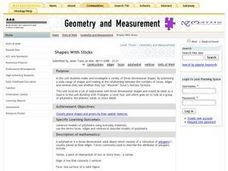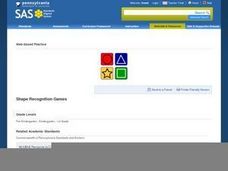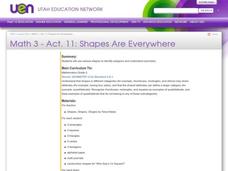Curated OER
Shapes Galore!
First graders explore two-dimensional shapes. Individually, children follow directions to draw shapes. Learners use shaving cream, geoboards, yarn, marshmallows, and toothpicks to create shapes. As a class, 1st graders brainstorm...
Curated OER
Shapes Galore!
First graders create two-dimensional shapes. In this shapes lesson, 1st graders learn about different two-dimensional shapes. Students have many hands-on experiences with these shapes including the use of geoboards, shaving cream, yarn,...
Curated OER
Shapes and Introduction to Geometry
Learners make a quilt. In this geometry lesson, students discuss patchwork quilts and learn some different geometric shapes and patterns that are commonly used. Learners explore designs with triangles and squares and then make their own...
Curated OER
Attributes of Shapes
There are five shapes for scholars to identify: rectangle, circle, square, trapezoid, and triangle. Although there isn't much here, consider projecting this as an all-class warm up. Ask kids to verbalize attributes of each...
Curated OER
Shapes and Patterns in Art and Oceans
First graders draw, cut out, and design their own fish shapes by cutting out shapes and putting them together. In this shapes and patterns worksheet, 1st graders also construct a stamp and print patterns with stamps to repeat a...
K-5 Math Teaching Resources
Pattern Blocks
Who needs to buy pattern blocks when you have this printable pattern block template? Including triangles, squares, trapezoids, rhombuses, and hexagons, this resource offers endless possibilities for teaching children about geometric shapes.
Digital Writing and Research Lab's – Lesson Plans
Teaching Close Reading through Short Composition/Revision
This activity may have writers evaluate short compositions, but their subjects are quite tall: great Americans. Pupils read one another's compositions and closely examine how specific phrases and diction contribute to shaping American...
Curated OER
Shapes and Their Insides
Learners follow a series of instructions for drawing and coloring different shapes in order to learn the difference between the perimeter and area of a polygon. Then they are asked to find the perimeter and area of a 3x4 rectangular...
Curated OER
Pattern Block Barrier Game
Challenge your learners to give clear and concise directions in this shape-name practice activity. In partners, they place a dividing "wall" between them, with pattern blocks and a grid on each side. Partner A places one block at a time...
Curated OER
Congruency
Some of these may look congruent, but examine them closely. There are three sets of shapes here for scholars to analyze as they circle all the congruent figures. For each set, there are three congruent shapes which are oriented in...
Curated OER
What's in the Bag?
Help your students identify the attributes of two-dimensional shapes. They read the book Round is a Mooncake, and use pattern blocks to sort shapes. Students sort shapes according to their attributes.
Curated OER
Patch Tool
Students use an Internet tool to explore shapes and how they combine. In this patterns lesson, students create quilting patterns using various shapes. Students recognize how the shapes fit together.
Exploratorium
Rotating String Shapes
Here is a very interesting way of studying triangles and polygons. Pupils work together and use pieces of string to create a variety of shapes. Depending on how many kids are manipulating the string at any one time, the number of...
Curated OER
I See Shapes
Students explore shapes through literature. For this language arts lesson, students read stories about shapes and discuss the shapes they see in the stories. Students find shapes around the room.
Curated OER
Shape Makers
Classify and explore shapes by giving learners opportunities to handle, describe and classify 2D and 3D shapes. Primary learners will sort objects such as triangles, squares, oblongs, circles, ovals, pentagons, hexagons, diamonds, boxes,...
Curated OER
Shapes with Sticks
Third graders investigate three dimensional shapes. They examine a variety of shapes and the relationship between the number of faces, edges, and vertices. Students determine Euler's formula and they create a variety of three dimensional...
Curated OER
Activities with 3-D shapes.
In this 3D shapes worksheet, students describe faces, feel shapes in a bag, use play dough to make shapes, and more. Students complete 8 activities.
Curated OER
Shape Recognition Games
Students explore shapes. In this math lesson, students identify basic geometric shapes. Students complete activities in which they identify shapes, symbols and letters. Students draw geometric shapes.
EngageNY
Close Reading: Understanding Carlotta’s Journey
How do incidents in A Mighty Long Way provoke the author, Carlotta Walls LaNier, to make certain decisions that shape her story? Scholars engage in a close reading of the memoir, analyzing events in US history and Carlotta's personal...
Curated OER
Looking at the World Through the Eyes of Chuck Close
First graders examine and analyze various works of art by Chuck Close. They listen to a book about Chuck Close, discuss images of his artwork, and create original paintings in the style of Chuck Close.
Curated OER
Activities with 2-D shapes.
For this 2D shapes worksheet, students complete activities such as describing features, matching edges, draw shapes, and more. Students complete 8 activities.
Curated OER
Using Geometric Shapes To Make Patterns
Sixth graders explore the use of shapes to create geometric patterns. they start with a simple example of dividing shapes in half to create two new ones. This can be extended to creating intricate patterns.
Curated OER
Finding the Shape of a Web
Students examine spider webs they find as they explore outside. They make T-chart of the shapes found in two different webs and draw them on geoboard paper. Next, they measure length and width of a spider's web before checking to see if...
Curated OER
Shapes Are Everywhere
Third graders use various shapes to identify polygons and understand symmetry. They explore pattern blocks noticing their similarities and differences, then share with other team members. They draw 3 polygons in their journals and...























